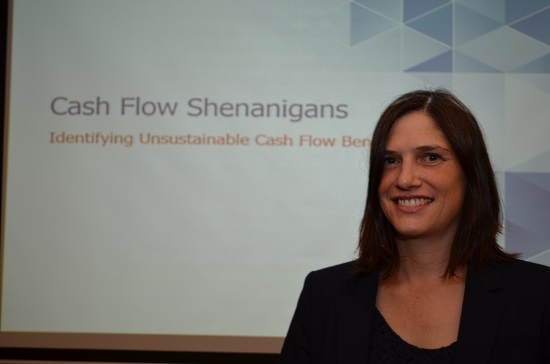 "Other than earnings, cashflow is an area that companies can manipulate to dress up their financial performance," said forensic accounting expert Jennifer Latz. Photo by Sim Kih
"Other than earnings, cashflow is an area that companies can manipulate to dress up their financial performance," said forensic accounting expert Jennifer Latz. Photo by Sim Kih
This article is republished, with permission, from the latest CFA Singapore quarterly newsletter which is produced by NextInsight.
CFRA is the global leader in forensic accounting research. Its Vice President, Jennifer Latz, was in Singapore in June to share her insights with CFA Singapore members on how companies may boost reported figures of cash flow from operations.
According to Ms Latz, there are four broad categories of cash flow manipulation – fraud, non-GAAP metrics, timing in payment of suppliers, and geographical allocation.
Here are a few examples from the discussion by Ms Latz, of how some companies make their cash flow metrics appear prettier.
Cash Balance Fraud
A fraudulent financial statement is the hardest to spot because one relies on the accuracy of numbers to draw conclusions.
Satyam Computer Services was a case of fraud that unfolded in 2009 when its chairman confessed to manipulating accounts by US$1.47 billion.
Investors wondered why US GAAP financials on Satyam accounts for the year ended March 2007 showed a highly unusual item: negative proceeds from sale of fixed assets. Indian accounting standards on the same showed positive proceeds.
It turned out that its senior management prepared materially false bank statements from fiscal year 2003 through September 2008.
During the 2008 Satyam audit, external auditors received conflicting information from two different branches of an Indian bank – one showed the presence of cash balances of US$176 million, another showed zero.
Unfortunately, the external auditors failed to make direct contact with the banks, choosing to rely exclusively on information provided by the Satyam management.
An investor can fall back on a couple of questions when examining company accounts:
- Is this really cash that is related to customers, suppliers or employees?
- Is the increase in cash flow from operations sustainable?







